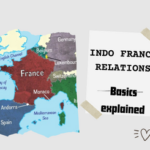Dense fog conditions are continued over North India

Dense to very dense fog conditions are continued over Punjab, Haryana, and Chandigarh.
LEARNING FROM HOME/ WITHOUT CLASSES/ BASICS
Fog is formed when air at or near the earth’s surface becomes saturated by any of the three processes – cooling (producing advection, radiation, or upslope fog), addition of moisture, or mixing with another air parcel. Generally, fog forms in a stable air mass environment. Fog does not generally form in an unstable atmosphere because vertical mixing results in convective or layered cloudiness.
Fog is often described as a stratus cloud resting near the ground. Fog forms when the temperature and dew point of the air approach the same value.
1) Advection fog. Advection fog forms due to moist air moving over a colder surface, and the resulting cooling of the near-surface air to below its dew-point temperature. Advection fog occurs over both water (e.g., steam fog) and land.
(2) Radiation fog (ground or valley fog). Radiational cooling produces this type of fog. Under stable night time conditions, long-wave radiation is emitted by the ground; this cools the ground, which causes a temperature inversion. In turn, moist air near the ground cools to its dew point. Depending upon ground moisture content, moisture may evaporate into the air, raising the dew point of this stable layer, accelerating radiation fog formation
Conduction
The air in interaction with the land gets heated gradually and the upper layers in touch with the lower layers also get heated. This process is called conduction. This process takes place when two bodies of uneven temperature are in contact with one another, there is a flow of energy from the warmer to the cooler body. This process is significant in heating the lower layers of the atmosphere.
Convection
This vertical heating of the atmosphere is known as convection. The air in contact with the earth upsurges vertically on heating in the form of currents and transfers the heat of the atmosphere. The convective transfer of energy is limited only to the troposphere.
Advection
The transfer of heat through the horizontal movement of air is called advection. Most of the diurnal variation in weather is caused by advection only in the middle latitudes.
This vertical heating of the atmosphere is known as convection in the range of visibility. This vertical heating of the atmosphere is known as convection. Mist contains a higher concentration of water droplets than fog. Mist contains a higher concentration of water droplets than fog.
Temperature inversions
The standard rule of meteorology is that air gets cooler with an increase in altitude. Temperature inversions occur when a layer of warm air traps cool air near the Earth’s surface. A temperature inversion usually happens during the night when the ground temperature drops because it’s no longer heated by the sun.





0 Comments